
Source: magazine on we heart it
By WebGlitzer

Source: magazine on we heart it
By WebGlitzer
←
SPACE WATCH
Field of Stars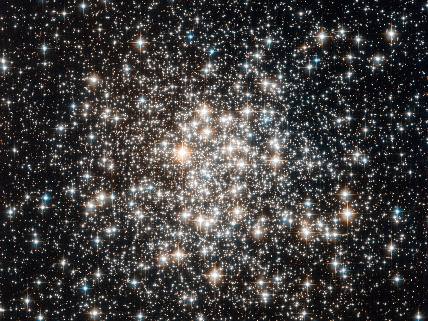 NASA – The Hubble Space Telescope captured a crowd of stars that looks rather like a stadium darkened before a show, lit only by the flashbulbs of the audience’s cameras. Yet the many stars of this object, known as Messier 107, are not a fleeting phenomenon, at least by human reckoning of time — these ancient stars have gleamed for many billions of years.
NASA – The Hubble Space Telescope captured a crowd of stars that looks rather like a stadium darkened before a show, lit only by the flashbulbs of the audience’s cameras. Yet the many stars of this object, known as Messier 107, are not a fleeting phenomenon, at least by human reckoning of time — these ancient stars have gleamed for many billions of years.
Messier 107 is one of more than 150 globular star clusters found around the disc of the Milky Way galaxy. These spherical collections each contain hundreds of thousands of extremely old stars and are among the oldest objects in the Milky Way. The origin of globular clusters and their impact on galactic evolution remains somewhat unclear, so astronomers continue to study them.
Messier 107 can be found in the constellation of Ophiuchus (The Serpent Bearer) and is located about 20,000 light-years from our solar system.
French astronomer Pierre Méchain first noted the object in 1782, and British astronomer William Herschel documented it independently a year later. A Canadian astronomer, Helen Sawyer Hogg, added Messier 107 to Charles Messier‘s famous astronomical catalogue in 1947.
This picture was obtained with the Wide Field Camera of Hubble’s Advanced Camera for Surveys. Image credit: ESA/NASA
Source: the Net economy
By WebGlitzer
←
SPACE WATCH
X-rays From A Young Supernova Remnant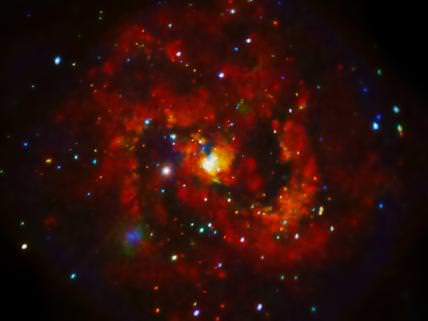 NASA – More than fifty years ago, a supernova was discovered in M83, a spiral galaxy about 15 million light years from Earth. Astronomers have used NASA’s Chandra X-ray Observatory to make the first detection of X-rays emitted by the debris from this explosion.
NASA – More than fifty years ago, a supernova was discovered in M83, a spiral galaxy about 15 million light years from Earth. Astronomers have used NASA’s Chandra X-ray Observatory to make the first detection of X-rays emitted by the debris from this explosion.
Named SN 1957D because it was the fourth supernova to be discovered in the year 1957, it is one of only a few located outside of the Milky Way galaxy that is detectable, in both radio and optical wavelengths, decades after its explosion was observed. In 1981, astronomers saw the remnant of the exploded star in radio waves, and then in 1987 they detected the remnant at optical wavelengths, years after the light from the explosion itself became undetectable.
A relatively short observation — about 14 hours long — from NASA’s Chandra X-ray Observatory in 2000 and 2001 did not detect any X-rays from the remnant of SN 1957D. However, a much longer observation obtained in 2010 and 2011, totaling nearly 8 and 1/2 days of Chandra time, did reveal the presence of X-ray emission. The X-ray brightness in 2000 and 2001 was about the same as or lower than in this deep image.
This new Chandra image of M83 is one of the deepest X-ray observations ever made of a spiral galaxy beyond our own. This full-field view of the spiral galaxy shows the low, medium, and high-energy X-rays observed by Chandra in red, green, and blue respectively.
The new X-ray data from the remnant of SN 1957D provide important information about the nature of this explosion that astronomers think happened when a massive star ran out of fuel and collapsed. The distribution of X-rays with energy suggests that SN 1957D contains a neutron star, a rapidly spinning, dense star formed when the core of pre-supernova star collapsed. This neutron star, or pulsar, may be producing a cocoon of charged particles moving at close to the speed of light known as a pulsar wind nebula.
If this interpretation is confirmed, the pulsar in SN 1957D is observed at an age of 55 years, one of the youngest pulsars ever seen. The remnant of SN 1979C in the galaxy M100 contains another candidate for the youngest pulsar, but astronomers are still unsure whether there is a black hole or a pulsar at the center of SN 1979C. Image Credits: X-ray: NASA/CXC/STScI/K.Long et al., Optical: NASA/STScI
Source: the Net economy
By WebGlitzer
←
SPACE WATCH
The Flame Nebula
 NASA – The Flame Nebula sits on the eastern hip of Orion the Hunter, a constellation most easily visible in the northern hemisphere during winter evenings. This view of the nebula was taken by WISE, NASA’s Wide-field Infrared Survey Explorer.
NASA – The Flame Nebula sits on the eastern hip of Orion the Hunter, a constellation most easily visible in the northern hemisphere during winter evenings. This view of the nebula was taken by WISE, NASA’s Wide-field Infrared Survey Explorer.
This image shows a vast cloud of gas and dust where new stars are being born. Three familiar nebulae are visible in the central region: the Flame Nebula, the Horsehead Nebula and NGC 2023. The Flame Nebula is the brightest and largest in the image. It is lit by a star inside it that is 20 times the mass of the sun and would be as bright to our eyes as the other stars in Orion’s belt if it weren’t for all the surrounding dust, which makes it appear 4 billion times dimmer than it actually is. Image Credit: NASA/JPL-Caltech/UCLA
Source: the Net economy
By WebGlitzer
←
SPACE WATCH
‘Like Salt Sprinkled on Black Velvet’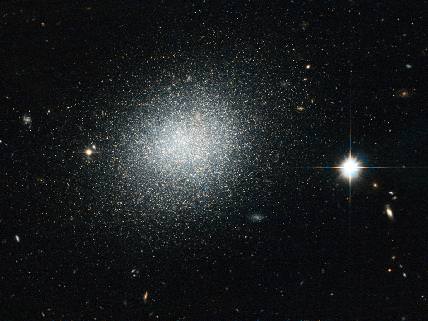 NASA – The NASA/ESA Hubble Space Telescope has captured this view of the dwarf galaxy UGC 5497, which looks a bit like salt sprinkled on black velvet in this image.
NASA – The NASA/ESA Hubble Space Telescope has captured this view of the dwarf galaxy UGC 5497, which looks a bit like salt sprinkled on black velvet in this image.
The object is a compact blue dwarf galaxy that is infused with newly formed clusters of stars. The bright, blue stars that arise in these clusters help to give the galaxy an overall bluish appearance that lasts for several million years until these fast-burning stars explode as supernovae.
UGC 5497 is considered part of the M 81 group of galaxies, which is located about 12 million light-years away in the constellation Ursa Major (The Great Bear). UGC 5497 turned up in a ground-based telescope survey back in 2008 looking for new dwarf galaxy candidates associated with Messier 81. Image Credit: ESA/NASA
Source: the Net economy
By WebGlitzer
←
SPACE WATCH
A Chance Alignment Between Galaxies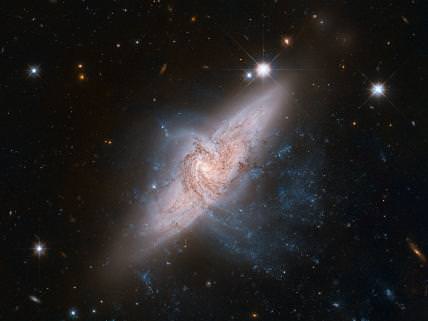 NASA – The Hubble Space Telescope shows a rare view of a pair of overlapping galaxies, called NGC 3314. The two galaxies look as if they are colliding, but they are actually separated by tens of millions of light-years, or about ten times the distance between our Milky Way and the neighboring Andromeda galaxy. The chance alignment of the two galaxies, as seen from Earth, gives a unique look at the silhouetted spiral arms in the closer face-on spiral, NGC 3314A. Image Credit: NASA, ESA, the Hubble Heritage Team (STScI/AURA)-ESA/Hubble Collaboration, and W. Keel (University of Alabama)
NASA – The Hubble Space Telescope shows a rare view of a pair of overlapping galaxies, called NGC 3314. The two galaxies look as if they are colliding, but they are actually separated by tens of millions of light-years, or about ten times the distance between our Milky Way and the neighboring Andromeda galaxy. The chance alignment of the two galaxies, as seen from Earth, gives a unique look at the silhouetted spiral arms in the closer face-on spiral, NGC 3314A. Image Credit: NASA, ESA, the Hubble Heritage Team (STScI/AURA)-ESA/Hubble Collaboration, and W. Keel (University of Alabama)
Source: the Net economy
By WebGlitzer
←
SPACE WATCH
Uncovering the Veil (Nebula)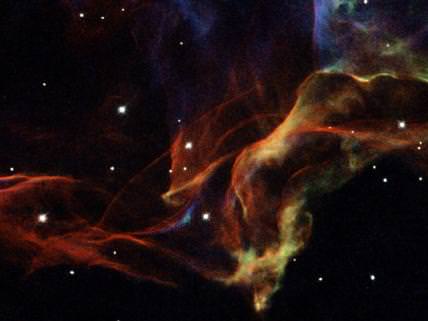 NASA – The Veil Nebula, left behind by the explosion of a massive star thousands of years ago, is one of the largest and most spectacular supernova remnants in the sky.
NASA – The Veil Nebula, left behind by the explosion of a massive star thousands of years ago, is one of the largest and most spectacular supernova remnants in the sky.
The image was taken with Hubble’s Wide Field Planetary Camera 2 in November 1994 and August 1997. Image Credit: NASA, ESA, and the Hubble Heritage (STScI/AURA)-ESA/Hubble Collaboration; Acknowledgment: J. Hester (Arizona State University)
Be the first to like this post.
Source: the Net economy
By WebGlitzer

Source: magazine on we heart it
By WebGlitzer

Source: magazine on we heart it